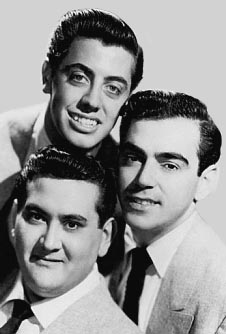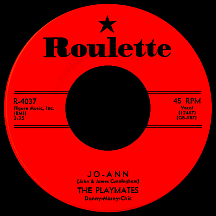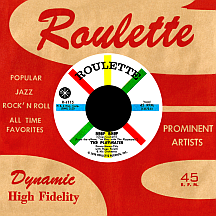THE PLAYMATES
Donny Conn, Morey Carr and Chic Hetti rank among the most outstanding popular singers of the mid-20th century. Their individual vocal chops were impressive enough; when it came to harmonizing, this trio from Waterbury, Connecticut (about 30 miles west of Hartford) approached perfection. A popular touring act in Canada in the early '50s, they could have played it straight like The Four Aces of Philadelphia, the era's most successful pop vocal group, or slightly off-center like Canadian quartet The Four Lads. Instead they staked a claim early as a novelty act, going by the name The Nitwits, singing silly songs (some of which they wrote) or humorously altering existing hits while acting up in front of audiences. But while crazy stage antics worked on the road, would the same schtick translate to the mostly non-visual medium of records?
They started out as The Donny Conn Trio while attending the University of Connecticut (located in Storrs, about 30 miles east of Hartford), intially a bare-bones band that performed standards (Chic, whose real name was Carl Cicchetti, played piano; Donny, whose real last name was Claps, played drums). Going largely unnoticed, they started doing funny bits to attract attention. As the Nitwits they played small clubs, even smaller rec centers and basically any dive that would pay a few bucks. Attempts at landing a recording contract went unfulfilled until Roulette Records was established in New York City in 1956 by George Goldner, Morris Levy and their business partners; the company had success right away with Buddy Knox and Jimmy Bowen, making two separate acts out of one band, The Rhythm Orchids. In early 1957, Conn's trio joined the still-spare Roulette roster as The Playmates.
Switching to a more "normal" name than Nitwits was a smart move, but it was not without certain drawbacks; for one thing, Hugh Hefner's Playboy magazine, which had become extremely popular since its December 1953 launch, featured Playmate of the Month centerfolds, exuding an image of female beauty and sexuality in 180-degree contrast to the three googly-eyed singing jokesters. For another thing, a rhythm and blues girl group from Newark called the Playmates (Gwen Brooks and sisters Lucille and Alma Beatty) appeared on Savoy at the same time Roulette's guys put out their first single. Easing off on the silly stuff, Donny and Chic composed a light little ditty called "Pretty Woman" for the group's debut. Next they went totally romantic with a cover of The Lovers' late-'57 R&B hit, "Darling it's Wonderful." Neither song caught on.
The third single was "Jo-Ann," a rock and roll ballad written by 16-year-old brothers Jim and John Cunningham of Long Island, who recorded the song for RCA Victor as The Twin-Tones. The Playmates' cover eclipsed the original, though in all fairness RCA never really pushed the Twin-Tones' version (it wasn't even issued as a single, appearing instead as the lead track on an EP). A third-time's-a-charm breakthrough for Donny's trio, it hit the top 20 in February 1958 (afterwards, the Cunninghams shortened their name to The Twins and released a sequel, "Jo-Ann's Sister"). Savoy's Playmates, meanwhile, changed their name to The Three Playmates and skirted the chart's edge in March with "Sugah Wooga." In a curious coincidence, the label of this and an earlier Savoy single credited their names (Lucille-Alma-Gwen) in a way oddly identical to how the "Jo-Ann" disc identified its Playmates (Donny-Morey-Chic).
So the competition had been pummeled, the name game was straightened out (in their favor) and the Playmates were off and running; the trio confidently began moving in a slightly more wacky direction as their Nitwit background was difficult to shake. "Let's Be Lovers," penned by Ben "Laughing on the Outside" Raleigh and Don "Azure Te" Wolf, risked going over-the-top with shrill female backing vocals ("la-la-la...LA-LA-LA!!!'), but it worked, at the very least, for younger listeners. "Don't Go Home," a Johnny Lehman-Stan Lebowski tune, made good use of gradually advancing key changes (to heighten the '...please don't leave the party yet' pleading) and landed the group another top 40 hit.
Perhaps the most ingenious song yet came from the pen of Sherman Edwards ("Wonderful! Wonderful!" by Johnny Mathis his best-known hit to that point). "The Day I Died" describes an out-of-body experience: 'I dreamed the jukebox played the day I died...and a million rock and rollers softly cried...' The track features female backing singers making 'wah...wa-a-ahh...wah' vocal effects and a line that might represent a goal of sorts: 'All the cats were wailin'...the gone-est is gone!' Add to this a clever melody and arrangement and spot-on vocals by Donny, Morey and Chic and you have a minor pop masterpiece better appreciated today than its number 81 chart peak would suggest.

The most famous of all Playmates records (and, unfortunately, the only one many people are familiar with) is "Beep Beep." Donny and Chic came up with the crazy Cadillac/Little Nash Rambler face-off, arranged with an accelerated tempo, that gave small car owners a good laugh (the luxury car drivers enjoyed the gag too) and sold over a million copies. Ah, the guilty pleasure of seeing the look on a Caddy driver's face when a compact jitney matches its speed...but can't get the car '...out of second gear!!!' The popularity of this late-'58 top ten hit caused an unintentional windfall for American Motors, the manufacturer of the Nash Rambler. Introduced in 1950 by the Nash-Kelvinator company (a precursor to American Motors), it represented a new phase in American auto manufacturing (following a concept that had already been in vogue for quite some time with European auto makers): a smaller, cheaper and more gas-efficient alternative to the larger Chevrolet, Ford and Plymouth models of AMC's "Big Three" Detroit competition. As soon as the record became a hit, sales of the Rambler American (a newer version of the compact Nash models of a few years earlier) increased sharply. In England, though, the BBC denied airplay to songs with brand names, so the Playmates rerecorded it, changing the Cadillac and Nash Rambler references to "limousine" and "bubble car," obscuring much of the song's humor in the process.
'Bright stars...Venus and Mars!'...okay, so not every song is as clever as the last, though "Star Love" has its own bubbly appeal; Goldner and the execs at Roulette felt the record should have done better considering it followed one of 1958's hottest hits. Enter Lee Pockriss and Paul Vance, the creators of Perry Como's top-selling "Catch a Falling Star." The fresh new songwriting team with a knack for penning pop-rock songs that teens could relate to (an approach deemed necessary if the still-in-their-twenties but vocally older-skewing Playmates were to continue having hits) would be behind all of the group's remaining hit singles.
"What is Love?" put them very much in favor with teenagers, though adults may have found lyrics like 'What is love? Five feet of heaven in a ponytail...the cutest ponytail that sways with a wiggle when she walks...' too corny to be taken seriously. The arrangement, as usual, was top-notch and it became the second biggest of all Playmates hits in the summer of 1959. Recordings of this type were interspersed with more serious fare (such as Ernest Gold and Steve Arlen's vocal theme from the bleak nuke flick On the Beach), but only the youthful Vance-Pockriss songs achieved any level of popularity. One of the best was "Wait For Me," a pull-at-the-heartstrings story of love lost due to poor timing that went top 40 in the fall of 1960 (Lynn Roberts answered with "Johnny, Wait For Me" on Roulette, told from the girl's perspective). Then along came "Little Miss Stuck-Up," sort of a "What is Love?" sequel concerning a schoolyard crush on a girl with '...here a wiggle, there a wiggle...' If these songs seemed too juvenile, they were certainly elevated by the quality of production and vocal talents of the trio. Perhaps the breaking point came in the summer of '62 with "Keep Your Hands in Your Pockets" ('...what a goofy, silly, kooky way to kiss!'), the group's final single to appear on the national charts.
Leaving Roulette in early 1963, they signed with ABC-Paramount and continued putting out semi-novelties like "'A' My Name is Alice," a Paul Vance-Eddie Snyder number that recycled the "Wait For Me" storyline. A couple of singles for Colpix in 1964 and '65 preceded a novelty 45 on Congress, "The Ballad of Stanley the Lifeguard," composed by the trio, which ended their recording endeavors for several years. They performed together off and on, then worked again with Vance and Pockriss on the 1971 single "Dayenyu (That Would Be Enough For Me)," released by Bell Records. A permanent split occurred at some point; Chic Hetti became a school teacher and Morey Carr went into real estate. Donny Conn worked in sales while keeping one foot in show business, singing and doing standup comedy and occasionally appearing on television.
So, to sum up where I stand: I like the Three Playmates of Savoy Records, based on the few songs I've heard by them. And I can't help liking the seven hundred-plus Playmates whose photos fold in two places. As for The Playmates of Westbury, Connecticut, they made some "Beep Beep"-in' good music for Roulette Records during the '50s and '60s.
NOTABLE SINGLES:
- Pretty Woman - 1957
- Darling it's Wonderful - 1957
- Jo-Ann - 1958
- Let's Be Lovers - 1958
- Don't Go Home - 1958
- The Day I Died - 1958
- Beep Beep - 1958
- Star Love - 1959
- What is Love? - 1959
- On the Beach - 1960
- Wait For Me - 1960
- Little Miss Stuck-Up - 1961
- Keep Your Hands in Your Pockets - 1962
- "A" My Name is Alice - 1963
- The Ballad of Stanley the Lifeguard - 1965
- Dayenyu (That Would Be Enough For Me) - 1971



